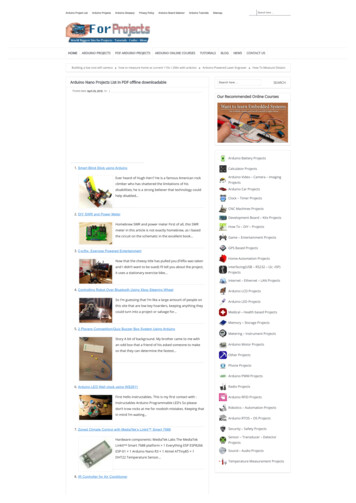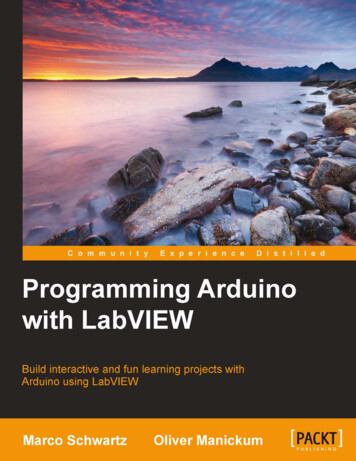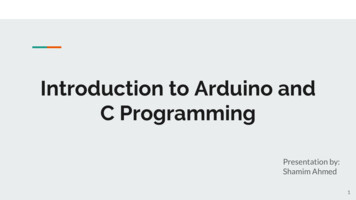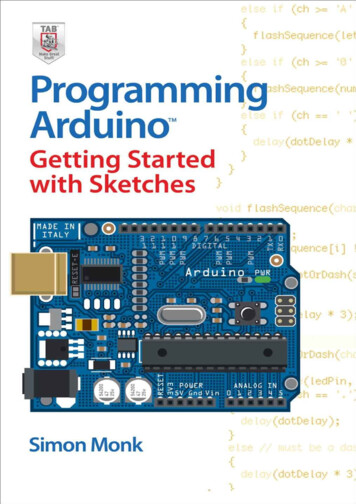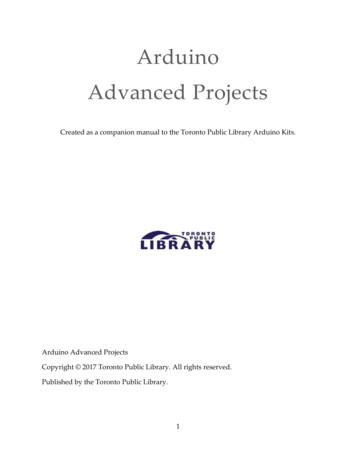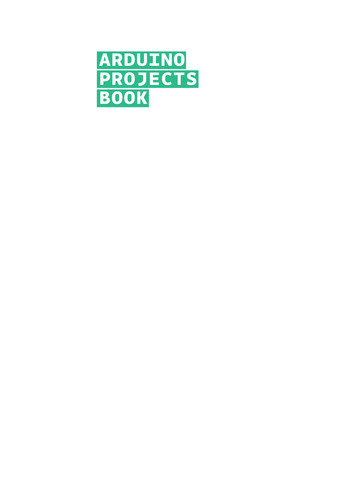
Transcription
ARDUINOPROJECTSBOOK
THE ARDUINO PROJECTS BOOKEDITORSProjects and text by Scott Fitzgerald and Michael ShilohAdditional text review by Tom IgoeDESIGN AND ART DIRECTIONTODOGiorgio Olivero, Mario Ciardulli, Vanessa Poli, Michelle Nebiolotodo.to.itDIGITAL FABRICATION AND PROJECT MANAGEMENTOfficine Arduino TorinoKatia De Coi, Enrico BassiADVISORS AND SUPPORTERSMassimo Banzi, Gianluca Martino, Smart ProjectsPROJECT TESTERS AND PROOFREADERSMichael Shiloh, Michelle Nebiolo, Katia De Coi, Alessandro Buat,Federico Vanzati, David MellisTHANKSBig thanks to the entire Arduino user community for their continued contributions, support, and feedback.Special thanks to the Fritzing team: some of the electronic components illustrations used in the book are taken or modified fromthe open-source Fritzing project (www.fritzing.org).Heartfelt thanks to Paul Badger for the CapacitiveSensor libraryused in Project 13.The text of the Arduino Projects Book is licensed under a CreativeCommons Attribution-NonCommercial-ShareAlike 3.0 License 2012 byArduino LLC. This means that you can copy, reuse, adapt and buildupon the text of this book non-commercially while attributing theoriginal work (but not in any way that suggests that we endorseyou or your use of the work) and only if the results are transmittedunder the same Creative Commons license.Full license terms: creativecommons.org/licenses/by-nc-sa/3.0/ 2012 Arduino LLC. The Arduino name and logo are trademarks ofArduino, registered in the US and in the rest of the world. Otherproduct and company names mentioned herein are trademarks of theirrespective companies.The information in this book is distributed on an “As Is” basiswithout any further warranties. While every precaution has beentaken in the design of this book, neither the authors nor ArduinoLLC shall have any liability to any person or entity with respectto any loss or damage caused or declared to be caused directly orindirectly by the instructions contained in this book or by thesoftware and hardware described in it.This book cannot be sold separately from The Arduino Starter Kit.Designed, printed and bound in Torino, ItalySeptember 2012
INDEX400INTRODUCTION2001Get to Know Your Tools3202Spaceship Interface4203Love-o-Meter5204Color Mixing Lamp6205Mood Cue7006Light Theremin7807Keyboard Instrument8608Digital Hourglass9409Motorized Pinwheel10210Zoetrope11411Crystal Ball12412Knock Lock13613Touchy-feely Lamp14414Tweak the Arduino Logo15615Hacking Buttons162A/Z GLOSSARY
00Everyone, every day, uses technology. Most of us leave theprogramming to engineers because we think coding andelectronics are complicated and difficult; actually, they can befun and exciting activities. Thanks to Arduino, designers, artists,hobbyists and students of all ages are learning to create thingsthat light up, move, and respond to people, animals, plants, andthe rest of the world.Over the years Arduino has been used as the “brain” in thousandsof projects, one more creative than the last. A worldwidecommunity of makers has gathered around this open-sourceplatform, moving from personal computing to personalfabrication, and contributing to a new world of participation,cooperation and sharing.Arduino is open and simple. It’s founded on lessons we’ve learnedteaching our own classes: if you start with the assumption thatlearning to make digital technologies is simple and accessible,you can make it so. Suddenly electronics and code becomecreative tools that anyone can use – like brushes and paint.This book walks you through the basics in a hands-on way, withcreative projects you build by learning. Once you’ve masteredthe basics, you’ll have a palette of software and circuits that youcan use to create something beautiful, and make someone smilewith what you invent.BECOME EXTRAORDINARY
WELCOME TOARDUINO!ARDUINO MAKES IT AS EASY AS POSSIBLETO PROGRAM TINY COMPUTERS CALLEDMICROCONTROLLERS, WHICH ARE WHAT MAKEOBJECTS INTERACTIVEYou are surrounded by dozens of them every day: they are embedded in timers,thermostats, toys, remote controls, microwave ovens, even some toothbrushes.They just do one specific task, and if you hardly notice them – which is often thecase – it’s because they are doing it well. They have been programmed to senseand control activity using sensors and actuators.Sensors listen to the physical world. They convert energy that you give off whenyou press buttons, or wave your arms, or shout, into electrical signals. Buttonsand knobs are sensors that you touch with your fingers, but there are many otherkinds of sensors.Actuators take action in the physical world. They convert electrical energy backinto physical energy, like light and heat and movement.Microcontrollers listen to sensors and talk to actuators. They decide what todo based on a program that you write.Microcontrollers and the electronics you attach to them are just the skeleton ofyour projects, though. You’ll need to bring skills you probably already have to putsome flesh on the bones.For example, in one of the projects we suggest, you’ll make an arrow and attach itto a motor, and put them both in a box with a knob, so you can make a meter totell people whether you’re busy or not. In another, you’ll put some lights and a tiltswitch on a cardboard frame to make an hourglass.Arduino can make your projects responsive, but only you can make thembeautiful. We’ll provide some suggestions along the way as to how you mightdo that.Arduino was designed to help you get things done. To make that happen, we keptthe background material on programming and electronics to a minimum. If youdecide you want to know more about these aspects, there are lots of good guidesavailable. We’ll provide a couple of references, and you can find more online at:arduino.cc/starterkit
6IntroductionWelcome to Arduino! - - -PARTS INYOUR KIT - Breadboard - A board on which you can buildelectronic circuits. It’s like a patch panel, withrows of holes that allow you to connect wiresand components together. Versions that require soldering are available, as well as the solder-less type used here.Arduino Uno - The microcontroller development board that will be at the heart of yourprojects. It’s a simple computer, but one thathas no way for you to interact with it yet. YouCapacitors - These components store and release electrical energy in a circuit. When thecircuit’s voltage is higher than what is stored inthe capacitor, it allows current to flow in, giving the capacitor a charge. When the circuit’swill be building the circuits and interfaces forvoltage is lower, the stored charge is released.Often placed across power and ground close tointeraction, and telling the microcontroller howto interface with other components.a sensor or motor to help smooth fluctuationsin voltage.Battery Snap - Used to connect a 9V battery topower leads that can be easily plugged into aDC motor - Converts electrical energy into mechanical energy when electricity is applied toits leads. Coils of wire inside the motor becomebreadboard or your Arduino.magnetized when current flows through them.
7These magnetic fields attract and repel magnets, causing the shaft to spin. If the directionof the electricity is reversed, the motor will spinin the opposite direction.- Diode - Ensures electricity only flows in one direction. Useful when you have a motor or otherhigh current/voltage load in your circuit. Diodes are polarized, meaning that the directionthat they’re placed in a circuit matters. Placedone way, they allow current to pass through.Placed the other way, they block it. The anodeside generally connects to the point of higherenergy in your circuit. The cathode typicallyconnects to the point of lower energy, or toground. The cathode is usually marked with aband on one side of the component’s body.Jumper wires - Use these to connect components to each other on the breadboard, and tothe Arduino.- Light Emitting Diodes (LEDs) - A type of diodethat illuminates when electricity passes throughit. Like all diodes, electricity only flows in onedirection through these components. You’reprobably familiar with these as indicators on avariety of electronic devices. The anode, whichtypically connects to power, is usually the longer leg, and the cathode is the shorter leg.Gels (red, green, blue) - These filter out different wavelengths of light. When used in conjunction with photoresistors, they cause thesensor to only react to the amount of light inthe filtered color.H-bridge - A circuit that allows you to controlthe polarity of the voltage applied to a load,usually a motor. The H-bridge in the kit is an in-Liquid Crystal Display (LCD) - A type of alphanumeric or graphic display based on liquid crystals. LCDs are available in a many sizes, shapes,tegrated circuit, but it could also be constructed with a number of discrete components.and styles. Yours has 2 rows with 16 characterseach.
8IntroductionWelcome to Arduino!Male header pins - These pins fit into femalesockets, like those on a breadboard. They helpmake connecting things much easier.Potentiometer - A variable resistor with threepins. Two of the pins are connected to the endsof a fixed resistor. The middle pin, or wiper,moves across the resistor, dividing it into twohalves. When the external sides of the potenOptocoupler - This allows you to connect twocircuits that do not share a common powersupply. Internally there is a small LED that,when illuminated, causes a photoreceptor inside to close an internal switch. When you apply voltage to the pin, the LED lights and theinternal switch closes. The two outputs replacea switch in the second circuit.tiometer are connected to voltage and ground,the middle leg will give the difference in voltageas you turn the knob. Often referred to as a pot.Pushbuttons - Momentary switches that closea circuit when pressed. They snap into breadboards easily. These are good for detecting on/off signals.Piezo - An electrical component that can beused to detect vibrations and create noises.Photoresistor - (also called a photocell, or lightdependent resistor). A variable resistor thatchanges its resistance based on the amount oflight that falls on its face.Resistors - Resist the flow of electrical energyin a circuit, changing the voltage and currentas a result. Resistor values are measured inohms (represented by the Greek omega character: Ω). The colored stripes on the sides ofresistors indicate their value (see resistor colorcode table).
9ling high current/high voltage components likemotors. One pin connects to ground, anotherto the component being controlled, and thethird connects to the Arduino. When the component receives voltage on the pin connectedto an Arduino, it closes the circuit between theground and the other component.Servo motor - A type of geared motor thatcan only rotate 180 degrees. It is controlled bysending electrical pulses from your Arduino.These pulses tell the motor what position itshould move to.Temperature sensor - Changes its voltage output depending on the temperature of the component. The outside legs connect to power andground. The voltage on the center pin changesas it gets warmer or cooler.Tilt sensor - A type of switch that will open orclose depending on its orientation. Typicallythey are hollow cylinders with a metal ball inside that will make a connection across twoleads when tilted in the proper direction.Transistor - A three legged device that can operate as an electronic switch. Useful for control-USB Cable - This allows you to connect yourArduino Uno to your personal computer forprogramming. It also provides power to the Arduino for most of the projects in the kit.
UNCONNECTED WIRESTRANSISTORPUSHBUTTONTILT SWITCHMOSFETMOTORRESISTORPHOTO RESISTORPOTENTIOMETERLEDDIODEPIEZOPOLARIZED CAPACITORCAPACITORBATTERYIn this book we will show you circuits both with realisticillustrations and with schematic diagrams.Illustrations will give you an idea of what the breadboardGROUNDmight look like in one possible implementation of the project.Schematics, instead, use symbols to capture the essence ofcircuits: they present the components and the ways they areconnected in a clear, succinct, and unambiguous form, but notCONNECTED WIREStheir physical organization. Schematics and schematic symbolsare how we communicate about circuits. As you explore the worldof electronics you will discover that some books and websitesonly provide schematic diagrams, so learning to read circuits thisway is a valuable skill.Here are the symbols we will be using throughout the book.TABLE OF SYMBOLS
11THE BOARDPower connectorReset ButtonThis is how you power yourArduino when it's not pluggedinto a USB port for power. Canaccept voltages between 7-12V.Resets the ATmegamicrocontroller.USB portUsed for powering yourArduino Uno, uploading yourTX and RX LEDssketches to your Arduino, andfor communicating with yourArduino sketch (via Serial.println() etc.)These LEDs indicate communication between your Arduinoand your computer. Expectthem to flicker rapidly duringsketch upload as well as duringserial communication. Usefulfor debugging.Digital pinsUse these pins with digitalRead(), digitalWrite(), andanalogWrite(). analogWrite()works only on the pins with thePWM symbol.Pin 13 LEDThe only actuator built-it toyour Arduino Uno. Besidesbeing a handy target for yourfirst blink sketch, this LED isvery useful for debugging.GND and 5V pinsUse these pins to provide 5VATmega microcontrollerThe heart of your Arduino Uno.power and ground to yourcircuits.Analog inUse these pins withPower LEDIndicates that your ArudinoanalogRead().is receiving power. Useful fordebugging.
12IntroductionWelcome to Arduino!Your Starter Kit includes a precut, easy-to-assemble woodenbase that will make working onall your projects – whetherthey are from this book or not– even easier.To build it, take the wood sheetout of the box and follow theinstructions on the right.Be careful to use only theparts that are shown, but don’tmisplace any of the otherpieces: you’ll need them forsome of the projects later.❶Let’s start!Take the wood sheet and carefully separate the pieces.❹Secure your Arduino Uno to the base using 3 screws. Becareful not to overtightens.
13❷❸Go on until you’ve separated all the parts.Place the pieces marked with an “A” into the holes inthe corners, in order to create the feet of the base.❺❻Carefully peel the backing from the breadboard.Stick the breadboard on the wooden sheet, next to theArduino UNO.
14IntroductionWelcome to Arduino!-THINGS YOUNEED TOSUPPLY9V batterySmall light source like aflashlightConductive material likealuminum foil or copper meshColored paperScissorsAn old CD or DVDTape and glueA box that you can makeholes intoBasic tools like a screwdriver9V battery powered componentAny battery powered electronic device with atleast one switch or pushbutton that you’re willing to hack into will do the job.Soldering iron and solder(necessary only in Project 15)
SETTINGUPWELCOME TO ARDUINO! BEFORE YOU START CONTROLLINGTHE WORLD AROUND YOU, YOU’LL NEED TO DOWNLOAD THEIDE TO PROGRAM YOUR BOARDThe Arduino IDE allows you to write programs and upload themto your Arduino.Download the latest version of the IDE from:arduino.cc/downloadHave your Arduino board and USB cable near your computer.Don’t plug them in just yet.Follow the appropriate procedures in the next pages for Windows,Mac OS X or Linux.The online version of this guide is available at:arduino.cc/guide
16IntroductionSetting UpOnline versionWINDOWSINSTALLATIONINSTRUCTION FOR:arduino.cc/windows❶When the download of the IDE finishes, unzip the downloadedfile. Make sure to preserve the folder structure. Double-click theWINDOWS 7, VISTA,folder to open it. There should be a few files and sub-foldersAND XPinside.❷Connect the Arduino to your computer with the USB cable. YourArduino will automatically draw power from either the USB connection to the computer or an external power supply.The green power light (labeled PWR) should turn on.❸Windows should initiate its driver installation process when theboard is plugged in. Your computer won’t be able to find the drivers by itself, so you’ll need to tell it where they are located.— Click on the Start Menu and open the Control Panel.— Navigate to “System and Security”. Open the Device Manager.— In Windows XP, look for the listing named "Ports (COM & LPT)"and right click on the "USB device" port; in Vista and Windows 7,right click on "Unknown device" under "Other devices".— Choose "Update Driver Software".— On Windows XP and Windows 7, you will be asked whetherto install automatically or "with a path". Chose the second option,"with a path". On Windows Vista proceed directly to the next step.— Select the “Browse my computer for Driver software” option.— Navigate to the folder you unzipped in the earlier step.Locate and select the “Drivers” folder in the main Arduino folder(not the “FTDI USB Drivers” sub-directory). Press “OK” and “Next”to proceed.— If you are prompted with a warning dialog about not passingWindows Logo testing, click “Continue Anyway”.— Windows now will take over the driver installation.In the Device Manager, you should now see a port listing similarto “Arduino UNO (COM4)”.Congratulations! You've installed the Arduino IDE on yourcomputer.
17Online versionMAC OS XINSTALLATIONINSTRUCTION FOR:OS X 10.5 ANDLATERarduino.cc/mac❶When the download of the IDE finished, double-click the .zip fle.❷Copy the Arduino application into the Applications folder, or❸Connect the board to the computer with the USB cable. The❹You do not need to install any drivers to work with the board.This will expand the Arduino application.wherever else you wish to install the software.green power LED (labeled PWR) should turn on.Depending on the version of OS X that you are running, youmight get a dialog box asking if you wish to open the “NetworkPreferences”. Click the “Network Preferences.” button, and then❺click “Apply”.The Uno will show up as “Not Configured”, but it is still working.You can quit the System Preferences.Congratulations! You have Arduino all set up and you're ready tostart making projects.LINUXINSTALLATIONIf you’re using Linux, please visit the website for instructions:arduino.cc/linux
18IntroductionSetting UpCOMMUNICATINGWITH THEARDUINO❶Now that you’ve installed the Arduino IDE and made sure yourcomputer can talk to the board, it’s time to make sure you can upload a program.Double-click the Arduino application to open it. If the IDE loadsin the wrong language, you can change this in the applicationpreferences. Look for “Language Support” on this page for details: arduino.cc/ide❷Navigate to the LED blink example sketch ('sketch' is what Arduino programs are called). It's located under:FILE EXAMPLES 01.BASICS BLINK❸❹A window with some text in it should have opened. Leave thewindow be for now, and select your board under:TOOLS BOARD menuChoose the serial port your Arduino is connected to from theTOOLS SERIAL PORT menu.— On Windows. This is likely to be the COM with the highestnumber. There is no harm in guessing wrong, and if it doesn’twork, try the next one. To find out, you can disconnect yourArduino board and re-open the menu; the entry that disappearsshould be the Arduino board. Reconnect the board and selectthat serial port.— On Mac. This should be something with /dev/tty.usbmodemin it. There are usually two of these; select either one.Fig. 1❺To upload the Blink sketch to your Arduino, press the UPLOADtoggle in the top left corner of the window. See Fig. 1.
19❻You should see a bar indicating the progress of the upload near thelower left corner of the Arduino IDE, and the lights labeled TX andRX on the Arduino board will be blinking. If the upload is successful,the IDE will display the message DONE UPLOADING.❼A few seconds after the upload has completed, you should see theyellow LED with an L next to it start blinking. See Fig. 2.If this is the case, congratulations! You’ve successfully programmed the Arduino to blink its onboard LED!Sometimes your brand new Arduino is already programmed withthe Blink sketch, so you can’t tell if you are truly in control. If this isthe case, change the delay time by changing the number in theFig. 2ADDITIONALINFORMATIONparenthesis to 100, and upload the Blink sketch again. Now theLED should blink much faster.Congratulations! You really are in control! Now it’s time to moveon to Project 1. (You needn’t save any changes you have made.)If you have problems with any of the steps outlined above, pleasesee the troubleshooting suggestions:arduino.cc/troubleWhile you’re getting ready to build your projects, you can look atthe following page for additional information about the Arduino’sprogramming environment:arduino.cc/ideYou might also want to look at:— the examples for using various sensors and actuatorsarduino.cc/tutorial— the reference for the Arduino languagearduino.cc/examples
INGREDIENTS220 OHM RESISTORLEDSWITCH01
21GET TO KNOWYOUR TOOLSYOU’LL MAKE A SIMPLE CIRCUIT WITH SOMESWITCHES, AN LED, AND A RESISTORDiscover: basic electrical theory, how a breadboard works,components in series and parallelTime: 30 MINUTESLevel:Electricity is a type of energy, much like heat, gravity, or light. Electrical energyflows through conductors, like wire. You can convert electrical energy into otherforms of energy to do something interesting, like turn on a light or make somenoise out of a speaker.The components you might use to do this, like speakers or light bulbs, are electrical transducers. Transducers change other types of energy into electrical energyand vice versa. Things that convert other forms of energy into electrical energy areoften called sensors, and things that convert electrical energy into other formsof energy are sometimes called actuators. You will be building circuits to moveelectricity through different components. Circuits are closed loops of wire witha power source (like a battery) and something to do something useful with theenergy, called a load.In a circuit, electricity flows from a point of higher potential energy (usually referred to as power or ) to a point of lower potential energy. Ground (often represented with a - or GND) is generally the point of least potential energy in a circuit.In the circuits you are building, electricity only flows in one direction. This type ofcircuit is called direct current, or DC. In alternating current (AC) circuits electricitychanges its direction 50 or 60 times a second (depending on where you live). Thisis the type of electricity that comes from a wall socket.There are a few terms you should be familiar with when working with electrical circuits. Current (measured in amperes, or amps; with the A symbol) is theamount of electrical charge flowing past a specific point in your circuit. Voltage(measured in volts; with the V symbol) is the difference in energy between onepoint in a circuit and another. And finally, resistance (measured in ohms; with theΩ symbol) is how much a component resists the flow of electrical energy.
Project 01Get to Know Your Tools22One way to imagine this is to think about a rockslide going downa cliff, as shown in Fig. 1. The higher the cliff, the more energy therocks will have when they hit the bottom. The height of the cliffis like the voltage in a circuit: the higher the voltage at the energysource, the more energy you have to use. The more rocks youhave, the more energy is being carried down the cliff. The number of rocks is like the current in an electrical circuit. The rocks gothrough bushes on the side of the cliff, losing some energy in theprocess; the energy is used up to crush the bushes. The bushesare like resistors in a circuit, offering resistance to the electricalflow and converting it into other forms of energy.Rockslide as a metaphor forCurrent (I)electrical current flow.Fig. 1Voltage (V)Resistance (R)A COUPLE OFTHINGS ABOUTCIRCUITSThere needs to be a complete path from the energy source(power) to the point of least energy (ground) to make a circuit.If there’s no path for the energy to travel, the circuit won’t work.All the electrical energy gets used up in a circuit by the com- 5V5V1123ponents in it. Each component converts some of the energy intoanother form of energy. In any circuit, all of the voltage is converted to another form of energy (light, heat, sound, etc.).The flow of current at a specific point in a circuit will alwaysbe the same coming in and going out.Electrical current will seek the path of least resistance toground. Given two possible paths, more of the electrical current4GNDwill go down the path with less resistance. If you have a connection that connects power and ground together with no resistance, you will cause a short circuit, and the current will try to current at (3) current at (4).follow that path. In a short circuit, the power source and wiresconvert the electrical energy into light and heat, usually as sparksor an explosion. If you’ve ever shorted a battery and seen sparks,Fig. 2you know how dangerous a short circuit can be.The current at (1) current at (2)
23WHAT’S ABREADBOARD?The breadboard is the primary place you will be building circuits.The one that comes in your kit is solderless, so named becauseyou don’t have to solder anything together, sort of like LEGO inelectronic form. The horizontal and vertical rows of the breadboard, as shown in Fig. 3, carry electrictricity through thin metalconnectors under the plastic with holes.The 5 holes in each horizontal row areconnected electrically through metalstrips inside the breadboard.The vertical strips that run the lengthof the breadboard are electricallyconnected. The strips are usually usedfor power and ground connections.The top of a breadboard and the connectionsunderneath.Fig. 3Conductive metal strips.The conductive plates inside a breadboard.Fig. 4The middle row breaks theconnection between the twosides of the board. - -POWER BUSPOWER BUSPROTOTYPING AREA
24Project 01Get to Know Your ToolsCIRCUITDRAWINGSThroughout these projects, you’ll see two views of circuits: one inbreadboard view (like in Fig. 5), that looks like the stuff in your kit.The other is a schematic view (like in Fig. 6), which is a more abstractway of showing the relationships between components in a circuit.Schematics don’t always show where components are placed relative to each other, but they show how they are connected. - - - -Circuit illustration.Fig. 5Schematic viewFig. 6
25YOUR FIRSTCOMPONENTSAn LED, or light-emitting diode, is a component that converts electrical energyinto light energy. LEDs are polarized components, which means they only allow-ANODECATHODEelectricity to flow through them in one direction. The longer leg on the LED is called an anode, it will connect to power. The shorter leg is a cathode and will connect to ground. When voltage is applied to the anode of the LED, and the cathodeis connected to ground, the LED emits light.A resistor is a component that resists the flow of electrical energy (see the components list for an explanation on the colored stripes on the side). It convertssome of the electrical energy into heat. If you put a resistor in series with a component like an LED, the resistor will use up some of the electrical energy and theLED will receive less energy as a result. This allows you to supply componentswith the amount of energy they need. You use a resistor in series with the LED tokeep it from receiving too much voltage. Without the resistor, the LED would bebrighter for a few moments, but quickly burn out.A switch interrupts the flow of electricity, breaking the circuit when open. When aswitch is closed, it will complete a circuit. There are many types of switches. Theones in your kit are called momentary switches, or pushbuttons, because they areonly closed when pressure is applied.SWITCH CONNECTIONSSWITCH SCHEMATIC VIEWThese two pins of a switch are connectedto each otherA - Toggle switch symbolThese two are not.They form the switchB - Pushbutton symbolThe switchFig. 7
26Project 01Get to Know Your ToolsBUILD THECIRCUIT - - - -Fig. 8Your first interactive circuit, using aswitch, a resistor and an LED.Arduino is just the power source forthis circuit; in later projects, you'llconnect its input and output pins tocontrol more complex circuits.Fig. 9
27You’re going to use the Arduino in this project, but only as asource of power. When plugged into a USB port or a 9-volt battery, the Arduino will provide 5 volts between its 5V pin and itsground pin that you can use. 5V 5 volts, you’ll see it writtenthis way a lot.❶If your Arduino is connected to a battery or computer via USB,❷Connect a red wire to the 5V pin on the Arduino, and put theunplug it before building the circuit!other end in one of the long bus lines in your breadboard. Connect ground on the Arduino to the adjacent bus line with a blackwire. It’s helpful to keep your wire color consistent (red for power, black for ground) throughout your circuit.❸Now that you have power on your board, place your switchacross the center of the board. The switch will sit across thecenter in one direction. The bend in the legs of the switch pointto the center of the board.❹Use a 220-ohm resistor to connect power to one side of theswitch. The illustrations in this book use 4 bands. Your kit mayhave a mix of 4 and 5 band resistors. Use the illustration on theside to check for the right one for this project. Look at page 41 fora detailed explanation of the color codes for resistors.On the other side of the switch, connect the anode (long leg)of the LED. With a wire connect the cathode (short leg) of theLED to ground. When you’re ready, plug the USB cable into theArduino.USE ITOnce everything is set to go, press the button. You should seethe LED light up. Congratulations, you just made a circuit! Onceyou’ve tired of pressing the button to tur
The text of the Arduino Projects Book is licensed under a Creative Commons A!ribution-NonCommercial-ShareAlike 3.0 License 2012 by Arduino LLC. This means that you can copy, reuse, adapt and build upon the text of this book non-commercially while a!ributing the original work (but not in any way that suggests that we endorse
